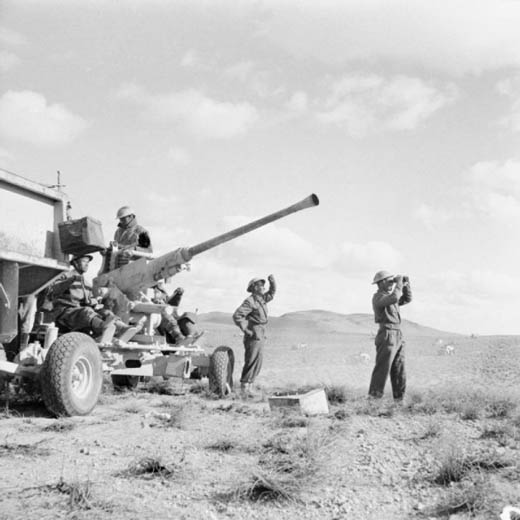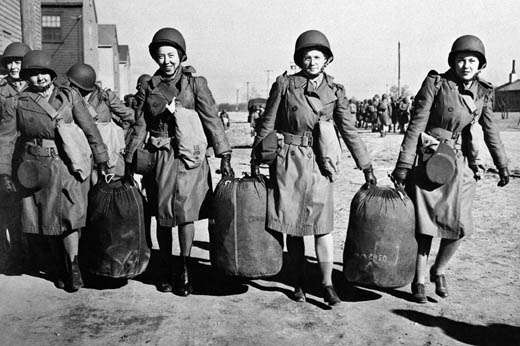Air Operations, Europe
BOMBER COMMANDDaylight Ops:
- 12 Bostons bomb a railway viaduct at Morlaix and 2 of 12 Venturas bomb a steelworks at Ijmuiden.
- 1 Boston is lost.
Bombs Falling on the Morlaix Viaduct |
 |
- 75 Wellingtons and 41 Halifaxes are sent to bomb Lorient. There is thick cloud cover and icing and with no Pathfinder marking, the bombs are well scattered.
- 2 Halifaxes and 2 Wellingtons are lost.
- 17 Wellingtons lay mines off the Biscay ports, and there are 5 OTU sorties over France in bad weather.
- 1 Wellington and 1 OTU aircraft are lost.
Air Operations, Mediterranean
XII Bomber Command B-26s claim direct hits on an Axis passenger liner during an anti-shipping sweep between Sicily and Tunisia.
[Air Operations, New Guinea
- V Bomber Command B-25s attack targets around Mubo.
- 374th Troop Carrier Group C-47s mount an emergency airlift of Australian Army reinforcements to a remote blocking position at the airfield at Wau, which is directly threatened by a fresh Japanese Army overland drive toward Port Moresby. The airlifted reinforcements, many of whom are landed virtually in the midst of close-range fighting at the airfield itself, help defeat the Japanese force, forcing it to retreat the next day, January 30.
Air Operations, Solomons
- XIII Bomber Command B-26s and XIII Fighter Command P-39s attack the Munda Point airfield on New Georgia and a bivouac at Vila, Kolombangara.
- A 347th Fighter Group P-38 downs a G4M 'Betty' bomber over Guadalcanal at about 0600 hours.
Air Operations, Tunisia
- Three waves of XII Bomber Command B-17s attack port facilities and shipping at Bizerte.
- While escorting XII Bomber Command B-26s in an attack against Tunis/El Aouina Airdrome, 82nd Fighter Group P-38 pilots down 2 Bf-109s.
Eastern Front
The Russians continue their advances on all the southern fronts. Kropotkin, a railway junction on the Rostov-Baku line, in the Caucasus is taken by the Russian 37th Army in the Kuban. Novyy Oskol north of Valuyki is also captured.
NORTHERN SECTORAs the fighting around Leningrad dies down, the Soviet armies take stock of their losses. Since January 12 the 67th Army has lost 12,000 killed and missing and 28,700 wounded, while 2nd Shock Army loses 19,000 killed and 46,000 wounded. The 8th Army, which has a minor role in the battle, lost 2,500 killed and missing and 5,800 wounded.
SOUTHERN SECTORHeavy fighting continues at Stalingrad as the three pockets are mercilessly attacked.
Kastornoye falls to the 38th Army after a ferocious battle. The Southwest Front begins the next phase of its attacks, aiming to outflank Army Group Don and penetrate the Donbas. Lead units of the Soviet 6th Army pushes forward northwest of Starobelsk, aiming to march straight for Balakleya. Elements push the Germans back to Kupyansk and cross the Krasnaya River on both sides of the town. The Germans retreat into Kupyansk and toward Izyum. The 1st Guards Army launches heavy attacks upon the 19th Panzer Division near Kabanye and Kremennaya.
[Germany, Home Front
- The Austrian Ernst Kaltenbrunner, SS Group Leader and Lt-Gen of Police, is appointed to head the SD. The previous chief was Heydrich who was assassinated in June 1942. (see above.)
- Sex murderer Bruno Lüdke claims his last victim - the 85th (?) since 1928. Lüdke is subsequently arrested and given a fatal injection April 8, 1944.
Guadalcanal
The CG, XIV Corps, detaches the 147th Infantry from the CAM Div, reinforced by pack howitzers of the 2nd Battalion, 10th Marines, and Battery A of the 97th Field Artillery Battalion, under the command of Brig-Gen Alphonse De Carre, is ordered to pass through the 6th Marines and continue to drive along the coast to Cape Esperance. The 182nd Infantry reverts to the control of the Americal Div.
The auxiliary carriers operate too slow and Giffen is told they will never make rendezvous the next evening. As a result, Giffen leaves the carriers with 2 destroyers and steams ahead without his built in air cover. Japanese planes have reported the cruiser force heading for Guadalcanal and in mid afternoon Adm Kusaka orders an air strike of Betty bombers to be made after dark. The task force is maintaining radio silence which prevents them from sending planes to check on radar blips that could be shadowing Japanese planes. 31 twin-engined bombers take off from Rabaul and Buka. The cruisers, travelling in two columns, are 50 miles north of Rennell Island, close to where they are to meet the destroyers. Half an hour after sunset the Japanese bombers arrive. Radar picks them up 60 miles to the west, but the US force, relaxing for the night, is unprepared for an attack. The bombers circle around to attack from the dark side and split into two groups. A torpedo bomber launches against the destroyer Waller (DD-466) and misses, then strafes the destroyer and the cruiser Wichita (CA-45). Another attacks the Louisville (CA-28). Her captain avoids the torpedo with a sharp turn to port. It seems the attack may be over. Giffen does not attempt any evasive moves, but steams on in a straight line.
The torpedo bombers come in again. Several planes drop flares that light up the ships brightly. A torpedo hits the Louisville (CA-28) but does not detonate as the inexperienced pilot drops too soon and the torpedo does not arm itself. The Chicago (CA-29) is hit by 2 torpedoes. At 2000 the attack over. Other ships are scarred but the Chicago (CA-29( is seriously damaged. The Louisville (CA-28) takes her in tow and heads back for Espiritu Santo.
[New Guinea
Australians airlift 800 troops to Wau, south of Lae, where a small Australian garrison faces overwhelmingly superior Japanese forces.
[North Africa
TUNISIAThe US 1st Division is placed under the command of the French XIX Corps to help defend the Ousseltia Valley. Combat Command B, US 1st Armored Div, reverts to the US II Corps.
40-mm Bofors Anti-Aircraft Gun |
 |
Pacific
- The giant Japanese submarine I-1 is sunk in an engagement with the New Zealand armed trawlers Kiwi and Moa off Kamimbo Bay, Guadalcanal.
- The US submarine Gato (SS-212) sinks the Japanese army cargo ship Nichiun Maru (2723t) off the southeast tip of Bougainville.
Solomons
In a battle continuing on into the 30th the US TF-18 under Adm Robert C. Giffen, covering a supply operation to Guadalcanal, is attacked by 31 Japanese G4M bombers 50 miles north of Rennel Island. Large formations of American aircraft take off from Guadalcanal and from carriers to engage the Japanese aircraft. The heavy cruiser Chicago (CA-29) is sunk by an aerial torpedo and a destroyer is damaged.
[ WAACs Heading for North Africa |
 |